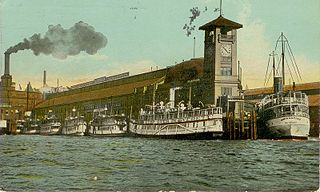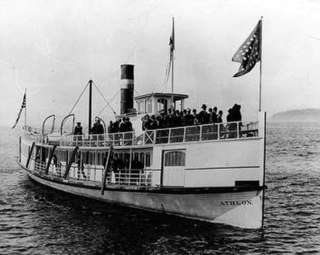
Ivar's is a seafood restaurant chain based in Seattle, Washington, United States, with operations in the Puget Sound region and in Spokane, Washington.

The steamship Virginia V is one of two last operational examples of Puget Sound Mosquito Fleet steamers. She was once part of a large fleet of small passenger and freight carrying ships that linked the islands and ports of Puget Sound in Washington state in the late 19th and early 20th centuries. She is a Seattle landmark and a National Historic Landmark.

The Puget Sound mosquito fleet was a multitude of private transportation companies running smaller passenger and freight boats on Puget Sound and nearby waterways and rivers. This large group of steamers and sternwheelers plied the waters of Puget Sound, stopping at every waterfront dock. The historical period defining the beginning and end of the mosquito fleet is ambiguous, but the peak of activity occurred between the First and Second World Wars.

Athlon was a typical passenger steamboat of the Puget Sound Mosquito Fleet.

The steamboat Monticello (2) operated in the early 1900s as part of the Puget Sound Mosquito Fleet. The vessel went through several reconstructions and remained in service until 1962, when she was lost in Alaska waters. Her later names were Penaco and Sea Venture. (This Puget Sound steamer should not be confused with the smaller Monticello, which also ran on Puget Sound, but was built in 1895 for Captain Z.J. Hatch of the Monticello Steamship Company.

The steamboat George E. Starr operated in late 19th century as part of the Puget Sound Mosquito Fleet and also operated out of Victoria, B.C. Geo. E. Starr also served for a time in California and on the Columbia River.

The Central Waterfront of Seattle, Washington, United States, is the most urbanized portion of the Elliott Bay shore. It runs from the Pioneer Square shore roughly northwest past Downtown Seattle and Belltown, ending at the Broad Street site of the Olympic Sculpture Park.

Ye Olde Curiosity Shop is a store founded in 1899, on the Central Waterfront of Seattle, Washington, United States. It is currently located on Pier 54. Best known today as a souvenir shop, it also has aspects of a dime museum, and was for many years an important supplier of Northwest Coast art to museums. As of 2008, the store has been owned by four generations of the same family.

Colman Dock, also called Pier 52, is the primary ferry terminal in Seattle, Washington, United States. The original pier is no longer in existence, but the terminal, now used by the Washington State Ferry system, is still called "Colman Dock".

Hyak was a wooden-hulled steamship that operated on Puget Sound from 1909 to 1941. This vessel should not be confused with the sternwheeler Hyak which ran on the extreme upper reach of the Columbia River at about the same time. The name means "swift" or "fast" in the Chinook Jargon.
The Kitsap County Transportation Company was an important steamboat and ferry company that operated on Puget Sound. The company was founded in 1898 as the Hansen Transportation Company.

Dode was a steamboat that ran on Hood Canal and Puget Sound from 1898 to 1900.

Sioux was a steamship which was operated on Puget Sound and the Strait of Juan de Fuca from 1912 to 1941. From 1924 to 1941, following reconstruction, the vessel operated as an auto ferry under the name Olympic. During the Second World War (1941-1945) this vessel was taken under the control of the U.S. Army and renamed the Franklin R. Leisenburg. The Liesenburg served as a ferry in the Panama Canal area under Army control, and then was sold to a firm which ran the vessel on the Surinam river in South America.

Camano was a steamboat built in 1906 at Coupeville, Washington which operated on Puget Sound from 1906 to 1917. Camano was later known as Tolo. As Tolo the vessel was sunk in 1917 as a result of a collision at sea. Four people died as a result.

Pier 1 in Seattle, Washington was an important shipping terminal.

Pier 2 in Seattle, Washington was an important shipping terminal.

The Grand Trunk Pacific dock was a shipping pier in Seattle, Washington. The original pier was built in 1910 and was destroyed in a fire in 1914. The pier was then rebuilt and continued in existence until 1964, when it was dismantled. The area where the pier stood is now part of the Seattle terminal of the Washington State Ferry system.

Pier 55 is a pier in Seattle, Washington. Pier 55 was originally known as Pier 4 until it was renumbered during World War Two.

The steamship General Frisbie was a wooden two-deck passenger ship built in 1900, named after John B. Frisbie. She was designed for use as a ferry between Vallejo and San Francisco. The steamer was successful in that role and was the fastest ship on the route when she began service. Improved roads, bridges, and automobiles reduced demand for ferry service in the Bay Area, and newer ships were optimized for transporting cars, so General Frisbie was retired in the late 1920s.






















